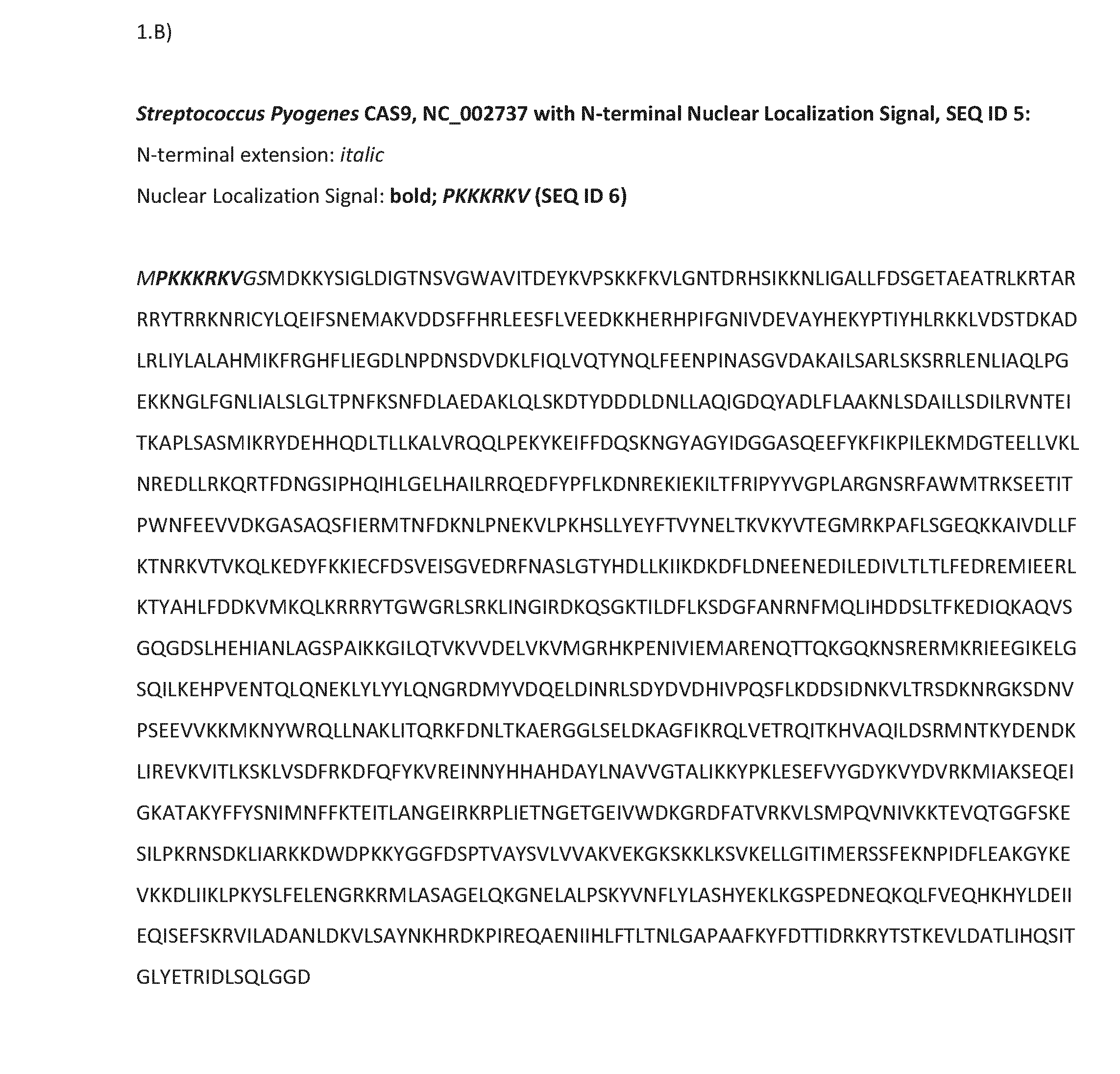Somatic human cell line mutations
a human cell line and mutation technology, applied in the field of somatic human cell line mutations, can solve the problems of small insertions or deletions, disrupting the gene of interest, and unable to target gene traps
- Summary
- Abstract
- Description
- Claims
- Application Information
AI Technical Summary
Benefits of technology
Problems solved by technology
Method used
Image
Examples
example 1
Generation of CRISPR Knockout Clones
[0360]HAP1 cells provide a valuable resource, enabling genetic studies in human cells. Herein described is a streamlined protocol that is robust and reliable and thus enables the routine generation of human knockout cell lines. To illustrate the capabilities of the technology, six examples of genes are shown for which HAP1 knockout cell lines were made using CRISPR / Cas technology.
TABLE 1Guide RNA sequenceGene(variable part)Genomic positionCHUKACAGACGTTCCCGAAGCCGCchr10: 101989200-101989220SEQ ID 98GSK3BCGGCTTGCAGCTCTCCGCAAchr3: 119812234-119812254SEQ ID 99RIPK2CGTCCGCCCGCCACGCAGACchr8: 90770386-90770406SEQ ID 100CDK4TCCCATCAGCACAGTTCGTGchr12: 58145335-58145355SEQ ID 101RIPK1AGTACTCCGCTTTCTGTAAAchr6: 3081216-3081236SEQ ID 102EEF2KTTGACATTCTGGTTCGAGCTchr16: 22237186-22237206SEQ ID 103
[0361]Guide RNAs were cloned into a proprietary expression vector in which guide RNA expression is directed by the U6 promoter. In this expression construct, the variabl...
example 2
Generation of CRISPR Knockout Clones
[0369]HAP1 cells provide a valuable resource, enabling genetic studies in human cells. The following example was made according to a streamlined protocol that is robust and reliable and thus enables the routine generation of human knockout cell lines. HAP1 knockout cell lines were made with respect to five examples of genes, using CRISPR / Cas technology.
TABLE 5Guide RNA sequenceGenomic Gene(variable part)positionOTUB1TCGGTCCTGCTGAGCCATGAchr11: SEQ ID 11863755839-63755859BRDTCCCAAAGCATTAACGTCAACchr1: SEQ ID 11992442875-92442895DDIT4GTTTGACCGCTCCACGAGCCchr10: SEQ ID 12074034099-74034119DDIT4LTCCTGAACCCAACCTCAACGchr4: SEQ ID 121101109279-101109299EIF4EBP1GGTGCTGAAGAGCGTGCCGCchr8: SEQ ID 12237888206-37888226
[0370]Guide RNAs were cloned into an expression vector in which guide RNA expression is directed by the U6 promoter. In this expression construct, the variable part of each guide RNA was fused a constant fusion RNA that contains parts of the crRNA a...
example 3
Production of a Haploid Clone Expressing Mutant EGFR Protein
[0377]The epidermal growth factor receptor (EGFR) regulates a number of cellular signaling pathways that promote cell growth and proliferation. Those include the NF-kB and the MAP / ERK signaling pathway. EGFR is mutated in a number of cancers (e.g. lung cancer and breast cancer) and most of these mutations are activating mutations that lead to elevated EGFR signaling in the resulting cells. One of the most predominant mutations found in non-small cell lung cancer is a single nucleotide exchange at position C2573T4G which leads to a single amino acid change in the kinase domain of the EGFR (Leu858Arg). The resulting mutant EGFR protein is constitutively active and thus promotes tumor growth.
[0378]In this example, CRISPR / Cas-mediated homologous recombination is employed in HAP1 cells to engineer the EGFR L858R mutation. Two guide RNAs are selected in the vicinity of the amino acid / site that was to be engineered (FIG. 9).
[0379]...
PUM
| Property | Measurement | Unit |
|---|---|---|
| freezing temperature | aaaaa | aaaaa |
| freezing temperature | aaaaa | aaaaa |
| freezing temperature | aaaaa | aaaaa |
Abstract
Description
Claims
Application Information
 Login to View More
Login to View More - R&D
- Intellectual Property
- Life Sciences
- Materials
- Tech Scout
- Unparalleled Data Quality
- Higher Quality Content
- 60% Fewer Hallucinations
Browse by: Latest US Patents, China's latest patents, Technical Efficacy Thesaurus, Application Domain, Technology Topic, Popular Technical Reports.
© 2025 PatSnap. All rights reserved.Legal|Privacy policy|Modern Slavery Act Transparency Statement|Sitemap|About US| Contact US: help@patsnap.com



